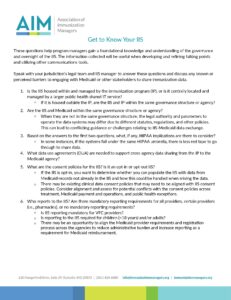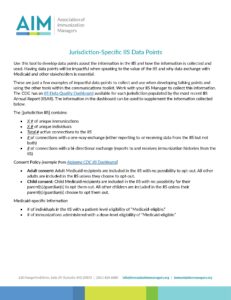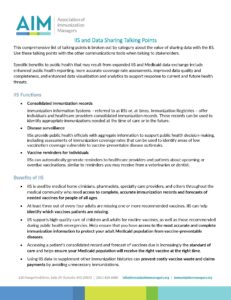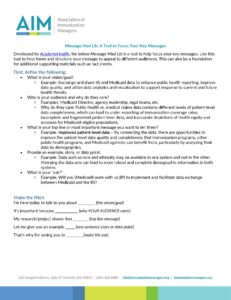Explore the IIS Communications Toolkit, which includes sample language, templates, slides, and talking points for immunization program managers to communicate the value of the IIS and its importance to the field of public health, emphasizing Medicaid partnerships.
Introduction
The IIS Communications Toolkit includes sample language, templates, slides, and talking points for immunization program managers (PMs) to communicate the value of the IIS and its importance to the field of public health. The tools focus on how to communicate the purpose, value, and importance of IIS, including what data it collects and how it is used in public health.
The resources focus on promoting data exchange between IIS and state Medicaid programs but could also be adapted to communicate the value of data exchange with other key partners. We suggest you use these resources with the guidance provided in the Collaborating With Medicaid to Improve Vaccination Rates checklist.
Have resources or tools that could benefit your peers? Please email Kristy Westfall with any suggestions or additions!
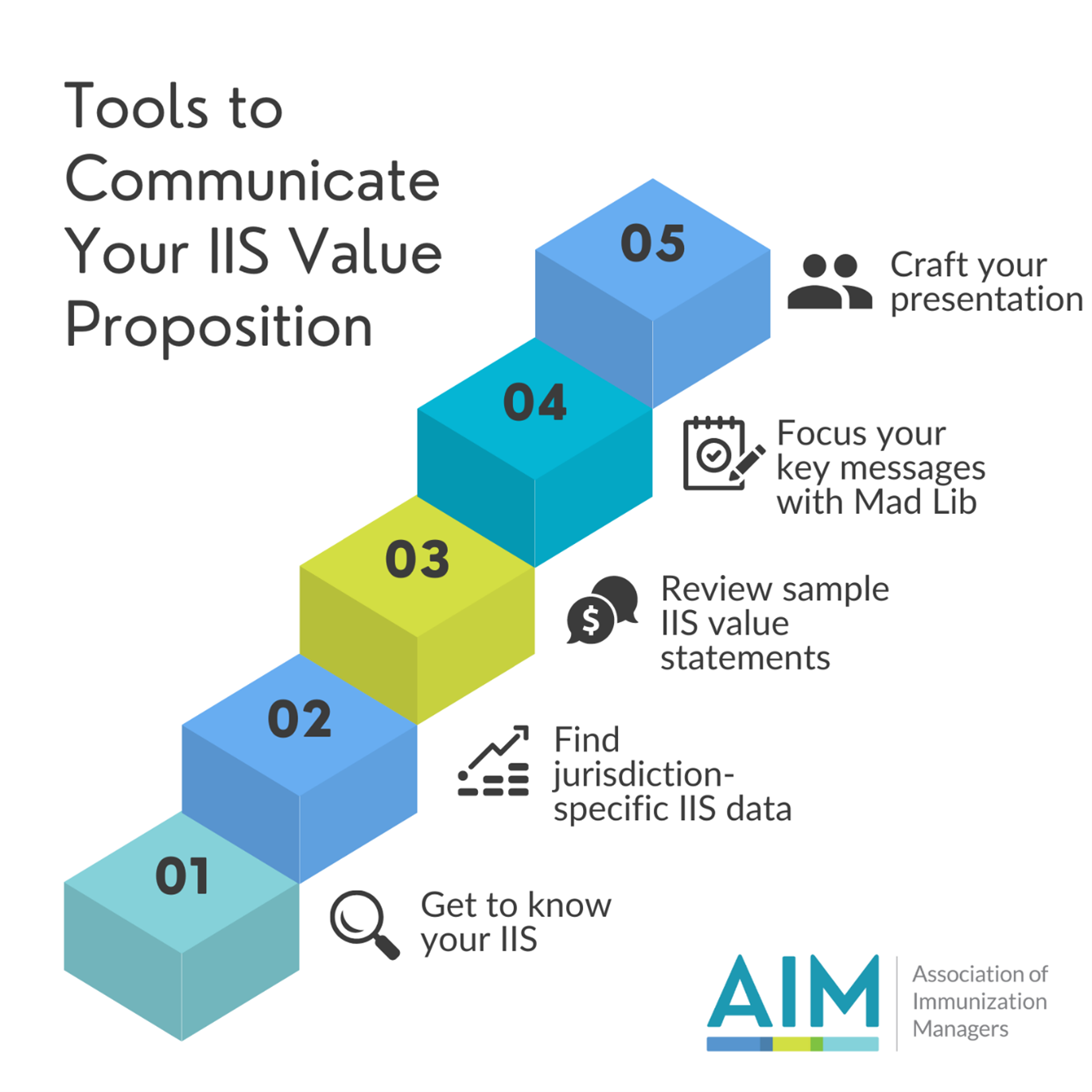
Tools & Resources
Get to Know Your IIS – A List of the Questions to Ask
This list of questions to ask your legal team and IIS staff will help you gain a foundational knowledge and understanding of the IIS governance, oversight, laws, and policies in your jurisdiction.
Use these questions to better understand your jurisdiction’s IIS. The information collected will be useful when developing and refining talking points and utilizing other communication tools.
Gathering Jurisdiction-Specific IIS Data Points – A List to Get You Started
This list of data points will be impactful when speaking about the value of the IIS.
Use this tool to develop jurisdiction-specific data points about the information in the IIS and how the information is collected and used. This can also be a foundation for additional supporting materials, such as fact sheets specific to your jurisdiction.
IIS Value Statements and Talking Points
This comprehensive list of talking points broken out by category shows the value of sharing data with the IIS.
Use these talking points with the other communication tools when talking to stakeholders.
Message Mad Lib – A Tool to Focus Your Key Messages
The Message Mad Lib is a tool to help focus your key messages.
Use this tool to help frame and structure your message to appeal to different audiences. This can also be a foundation for additional supporting materials, such as fact sheets specific to your jurisdiction.
Communicating the Value of IIS – PowerPoint slide deck
This customizable slide deck defines an IIS, explains its value, and provides easy-to-use slide templates to share jurisdiction-specific information. Download and customize the PowerPoint slide deck.
Being able to show the impact of IIS data is crucial when communicating the value of data sharing with stakeholders.
Get to Know Your IIS
These questions help program managers gain a foundational knowledge and understanding of the governance and oversight of the IIS. The information collected will be useful when developing and refining talking points and utilizing other communications tools.
Speak with your jurisdiction’s legal team and IIS manager to answer these questions and discuss any known or perceived barriers to engaging with Medicaid or other stakeholders to share immunization data.
1. Is the IIS housed within and managed by the immunization program (IP), or is it centrally located and managed by a larger public health shared IT service?
-
- If it is housed outside the IP, are the IIS and IP within the same governance structure or agency?
2. Are the IIS and Medicaid within the same governance structure or agency?
-
- When they are not in the same governance structure, the legal authority and parameters to operate the data systems may differ due to different statutes, regulations, and other policies. This can lead to conflicting guidance or challenges relating to IIS-Medicaid data exchange.
3. Based on the answers to the first two questions, what, if any, HIPAA implications are there to consider?
-
- In some instances, if the systems fall under the same HIPAA umbrella, there is less red tape to go through to share data.
4. What data use agreements (DUA) are needed to support cross-agency data sharing from the IP to the Medicaid agency?
5. What are the consent policies for the IIS? Is it an opt-in or opt-out IIS?
-
- If the IIS is opt-in, you want to determine whether you can populate the IIS with data from Medicaid records not already in the IIS and how this could be handled when mixing the data.
- There may be existing clinical data consent policies that may need to be aligned with IIS consent policies. Consider alignment and assess potential conflicts with the consent policies across treatment, Medicaid payment and operations, and public health exceptions.
6. Who reports to the IIS? Are there mandatory reporting requirements for all providers, certain providers (i.e., pharmacies), or no mandatory reporting requirements?
-
- Is IIS reporting mandatory for VFC providers?
- Is reporting to the IIS required for children (<18 years) and/or adults?
- There may be an opportunity to align the Medicaid provider requirements and registration process across the agencies to reduce administrative burden and increase reporting as a requirement for Medicaid reimbursement.
7. Who can access the IIS (on a view-only or edit basis), e.g., schools, child care centers, academic institutions, WIC, etc.
-
- Is IIS access determined through policy at the immunization program level or legislation? Policies can be updated more easily and quicker than legislation that may require more planning and time.
8. Does the IIS obtain data from or report data to other states?
-
- If so, which states does the IIS exchange data with?
- If not, are there barriers to connecting to the CDC’s Immunization Gateway (IZ Gateway) for exchange with other states and federal partners?
9. Is there legislation governing the IIS and/or current legislative proposals that might impact IIS functionality and reporting?
-
- Find out how to become aware of proposed legislation impacting immunizations, the immunization program, or IIS as soon as possible.
- Educate leadership and decision makers who will help address specific challenges or who can provide strong support for or against a bill, identify supplemental resources, assist with regulatory changes, facilitate cross-agency collaboration, etc.
10. What improvements were made to the IIS during the pandemic?
-
- What were the previous challenges before the pandemic?
- Are there current challenges that are still outstanding?
11. Determine who is leading the Data Modernization Initiative (DMI) in your state to see how the IIS is incorporated into the DMI or other initiatives.
-
- DMI has funding attached to it and could be an opportunity to supplement IIS funding for modernizing the IIS functionality and data exchange.
Jurisdiction-Specific IIS Data Points
Use this tool to develop data points about the information in the IIS and how the information is collected and used. Having data points will be impactful when speaking to the value of the IIS and why data exchange with Medicaid and other stakeholders is essential.
These are just a few examples of impactful data points to collect and use when developing talking points and using the other tools within the communications toolkit. Work with your IIS manager to collect this information. The CDC has an IIS Data Quality Dashboard available for each jurisdiction populated by the most recent IIS Annual Report (IISAR). The information in the dashboard can be used to supplement the information collected below.
The [jurisdiction IIS] contains:
- X # of unique immunizations
- X # of unique individuals
- Total # active connections to the IIS
- # of connections with a one-way exchange (either reporting to or receiving data from the IIS but not both)
- # of connections with a bi-directional exchange (reports to and receives immunization histories from the IIS)
Consent Policy [example from Alabama CDC IIS Dashboard]
- Adult consent: Adult Medicaid recipients are included in the IIS with no possibility to opt-out. All other adults are included in the IIS unless they choose to opt-out.
- Child consent: Child Medicaid recipients are included in the IIS with no possibility for their parent(s)/guardian(s) to opt them out. All other children are included in the IIS unless their parent(s)/guardian(s) choose to opt them out.
Medicaid-specific Information
- # of individuals in the IIS with patient-level eligibility of “Medicaid-eligible.”
- # of immunizations administered with a dose-level eligibility of “Medicaid-eligible.”
IIS and Data Sharing Talking Points
This comprehensive list of talking points is broken out by category about the value of sharing data with the IIS. Use these talking points with the other communication tools when talking to stakeholders.
Specific benefits to public health that may result from expanded IIS and Medicaid data exchange include enhanced public health reporting, more accurate coverage rate assessments, improved data quality and completeness, and enhanced data visualization and analytics to support response to current and future health threats.
IIS Functions
- Consolidated immunization records
- Immunization Information Systems – referred to as IISs or, at times, Immunization Registries – offer individuals and healthcare providers consolidated immunization records. These records can be used to identify appropriate immunizations needed at the time of care or in the future.
- Disease surveillance
- IISs provide public health officials with aggregate information to support public health decision-making, including assessments of immunization coverage rates that can be used to identify areas of low vaccination coverage vulnerable to vaccine-preventable disease outbreaks.
- Vaccine reminders for individuals
-
- IISs can automatically generate reminders to healthcare providers and patients about upcoming or overdue vaccinations, similar to reminders you may receive from a veterinarian or dentist.
Benefits of IIS
- IIS is used by medical home clinicians, pharmacists, specialty care providers, and others throughout the medical community who need access to complete, accurate immunization records and forecasts of needed vaccines for people of all ages.
- At least three out of every four adults are missing one or more recommended vaccines. IIS can help identify which vaccines patients are missing.
- IIS supports high-quality care of children and adults for routine vaccines and those recommended during public health emergencies. Help ensure you have access to the most accurate and complete immunization information to protect your adult Medicaid population from vaccine-preventable diseases.
- Accessing a patient’s consolidated record and forecast of vaccines due is increasingly the standard of care and helps ensure your Medicaid population will receive the right vaccine at the right time.
- Using IIS data to supplement other immunization histories can prevent costly vaccine waste and claims payments by avoiding unnecessary immunizations.
- IIS supports collaboration, coordination, communication, and documentation among members of the immunization neighborhood and care delivery teams.
Value Proposition of IIS-Medicaid Partnership and Data Exchange
- Enhanced public health reporting
- Combined data sets provide a more accurate view of disparities based on geography, social determinants of health, race or ethnicity, and others. This allows public health and community leaders to make better-informed decisions and tailor outreach to under-resourced communities.
- More accurate coverage rate assessments
- Public health data and medical claims data differ regarding patient-level data completeness. Combined data allows immunization programs and Medicaid agencies to analyze immunization coverage and uptake by demographics such as race and ethnicity with greater accuracy and confidence.
- Improved data quality and completeness
- Cross-jurisdictional IIS data exchange has grown significantly since the beginning of COVID. Additionally, more IISs are now connected to the CDC’s Immunization Gateway (IZ Gateway), which includes federal partners such as the Veterans Health Administration, the Department of Defense, and large health systems spanning multiple states and jurisdictions. These connections provide more complete and accurate immunization histories for individuals in the jurisdiction that Medicaid and other stakeholders may otherwise not have access to.
- Enhanced data visualization and analytics to support response to current and future health threats
- COVID-19 highlighted the interest and necessity of public-facing data reports and dashboards to display health outcomes within communities, including specific populations such as Medicaid recipients. When data sets are combined and used to report this information clearly and consistently, it builds trust in the data and immunization programs.
IIS-Medicaid Data Sharing for Sustainability
- Workforce and training
- Public health often struggles to compete with the private sector in recruiting and retaining employees with the skills necessary to maintain and operate data systems. Strong relationships between immunization programs (IPs) and Medicaid facilitate sharing the data and informatics workforce needed to analyze, cleanse, and improve the data in both systems. This collaboration allows data analytics and reporting to become a shared service, creating centralized public dashboards within one location instead of being traditionally siloed.
- Data resiliency and contingency planning
- Data contingency planning is critical. Capturing and storing data in multiple systems can alleviate data loss or reduce the downtime necessary for data retrieval and system re-population.
- The COVID-19 pandemic pushed the public health data infrastructure and information systems to their limits. Strengthening and expanding partnerships between IIS and Medicaid is a great solution to address the increased demand for IIS and Medicaid systems and provide data contingencies.
Financial Benefits of IIS-Medicaid Data Sharing
- Performance-based payments
- Collaborating with IIS to obtain accurate and timely immunization data can help Quality Improvement Organizations (QIOs) receive performance-based payments for achieving specific quality improvement targets related to immunization. These targets may include increasing immunization rates, reducing vaccine-preventable diseases, enhancing data accuracy and completeness, and improving overall immunization outcomes. QIOs that demonstrate exceptional performance in these areas can earn financial incentives tied to their success.
- HEDIS reporting
- Most managed care plans must report immunization-related Healthcare Effectiveness Data and Information Set (HEDIS) metrics to the state Medicaid agency. One often-used metric is immunization status. Managed Care Organizations (MCOs) often obtain data from the IIS to supplement or validate patient immunization data. Connecting the IIS to the main Medicaid data and technology ecosystem can ease the burden of data sharing.
- Evidence-based strategies
- These strategies for improving vaccine coverage can help alleviate the costly burden of disease that could otherwise be prevented through timely immunizations.
- Quality measures
- Shared IIS performance measures enable Medicaid agencies to compare outcomes across health plans, aiming toward better patient care and lower costs.
Reducing the Burden of Disease
- Enhanced vaccination reminder and recall systems
- Data sharing between Medicaid and IIS enables the development of robust vaccination reminder and recall systems. These systems can automatically generate reminders to healthcare providers and patients about upcoming or overdue vaccinations.
- By leveraging the comprehensive data available through IIS, Medicaid programs can implement proactive outreach strategies, sending reminders via mail, phone calls, text messages, or electronic notifications. This helps to ensure that individuals stay on schedule with their immunizations, thereby reducing the likelihood of outbreaks and minimizing the burden of vaccine-preventable diseases.
- Tailored public health interventions
- Analyzing shared data helps public health agencies and Medicaid identify geographic areas or communities at higher risk for vaccine-preventable disease outbreaks due to low immunization rates. This allows for tailored interventions, including educational campaigns, immunization clinics, and outreach programs. By focusing resources where they are needed most, data sharing can help mitigate the burden of disease by improving immunization rates in these communities.
Examples of Public Health Data to Support Medicaid Operations, Programs, and Populations
For Medicaid Enterprise Systems’ (MES’) enhanced match through Federal Financial Participation (FFP), they must identify outcomes-based measures demonstrating improvement. A short list of examples is noted below specific to immunization data:
- Identify Medicaid CHIP beneficiary immunization schedule gaps and send data sets and files to Medicaid on a monthly or quarterly basis to improve awareness, outreach, and tracking of CHIP immunization rates. CHIP carries immunization coverage requirements from CMS.
- Resource: State Health Official Letter (May 11, 1998)
- Resource: Commonwealth Fund: Using Medicaid Managed Care to Boost Immunization Rates(March 3, 2022)
- Resource: MACPAC: Vaccine Access for Adults Enrolled in Medicaid(March 24, 2022)
- Identify the Medicaid adult population immunization gaps required by the Advisory Committee on Immunization Practices (ACIP):
- Influenza
- Tetanus, diphtheria, and acellular pertussis (Tdap)
- Human papillomavirus (HPV)
- Pneumococcal polysaccharide vaccine (PPSV23)
- Pneumococcal conjugate vaccine (PCV13)
-
- Send report monthly for outreach MCOs or PCPs and to close the immunization gaps. *AK Medicaid may be changing Medicaid coverage policies to cover these vaccines.
- Resource: NAACHO: Inflation Reduction Act: Improving Adults Enrolled in Medicaid and Medicare Access to Recommended Vaccines(January 17, 2023)
- Resource: Avalere Health: Adult Vaccine Coverage in Medicaid: Assessing the Existing Gaps and Looking Ahead to Implementation of the Inflation Reduction Act(December 2022)
- Support Medicaid immunization metrics and rates (California example)
- Providing a comprehensive immunization record that can adapt to changes in the medical home or health insurance
- Calculating which vaccinations children need and minimizing under- or over-immunization
- Issuing reminders of upcoming visits
- Identifying individuals and populations with low immunization rates
-
- Resource: NASHP: State Medicaid Levers to Promote Immunizations: California’s Experience (September 9, 2019)
Message Mad Lib: A Tool to Focus Your Key Messages
Developed by AcademyHealth, the below Message Mad Lib is a tool to help focus your key messages. Use this tool to help frame and structure your message to appeal to different audiences. This can also be a foundation for additional supporting materials such as fact sheets.
First, define the following:
- What is your vision/goal?
- Example: Exchange and share IIS and Medicaid data to enhance public health reporting, improve data quality, and utilize data analytics and visualization to support response to current and future health threats.
- Who is your audience, and why do they care?
- Examples: Medicaid Director, agency leadership, legal teams, etc.
- Why do they care: Public health vs. medical claims data contains different levels of patient-level data completeness, which can lead to under-reporting of immunization coverage rates, incomplete and fragmented patient-level data, and inaccurate depictions of health equity and accesses for Medicaid-eligible populations.
- What is your top line or most important message you want to tell them?
- Example: Improved patient-level data – By connecting the data, there are opportunities to improve the patient-level data quality and completeness that immunization programs, other public health programs, and Medicaid agencies can benefit from, particularly by analyzing their data by demographics.
- Provide an example, story, or data point.
-
- Example: Data such as race and ethnicity may be available in one system and not in the other. Marrying the data sets can lead to more robust and complete demographic information in both systems.
- What is your “ask?”
- Example: Will you (Medicaid) work with us (IP) to implement and facilitate data exchange between Medicaid and the IIS?
Make the Pitch
I’m here today to talk to you about _________ (the vision/goal)
It’s important because ____________ (why YOUR AUDIENCE cares)
My research/project shows that ________ (top-line message)
Let me give you an example _____ (one sentence story or data point)
That’s why I’m asking you to _________(make the ask)
From the above example:
I’m here today to talk to you about the value of exchanging and sharing IIS and Medicaid data to enhance public health reporting, improve data quality, and utilize data analytics and visualization to support response to current and future health threats.
It’s important because, as the [state] Medicaid Director, you are most likely aware that public health vs. medical claims data contains different levels of patient-level data completeness, which can lead to under-reporting of immunization coverage rates, incomplete and fragmented patient-level data, and inaccurate depictions of health equity and accesses for Medicaid-eligible populations.
My research into other states and similar data-sharing partnerships shows that by connecting, sharing, and exchanging the data from the IIS and Medicaid, there are opportunities to improve the patient-level data quality and completeness that immunization programs, other public health programs, and Medicaid agencies can benefit from, particularly to analyze their data by demographics.
Let me give you an example. Data such as race and ethnicity may be available in one system and not in the other. Marrying the data sets can lead to more robust and complete demographic information in both systems.
That’s why I’m asking you (Medicaid) to work with us (IP) to implement and facilitate data exchange between the Medicaid claims data system and the IIS.

